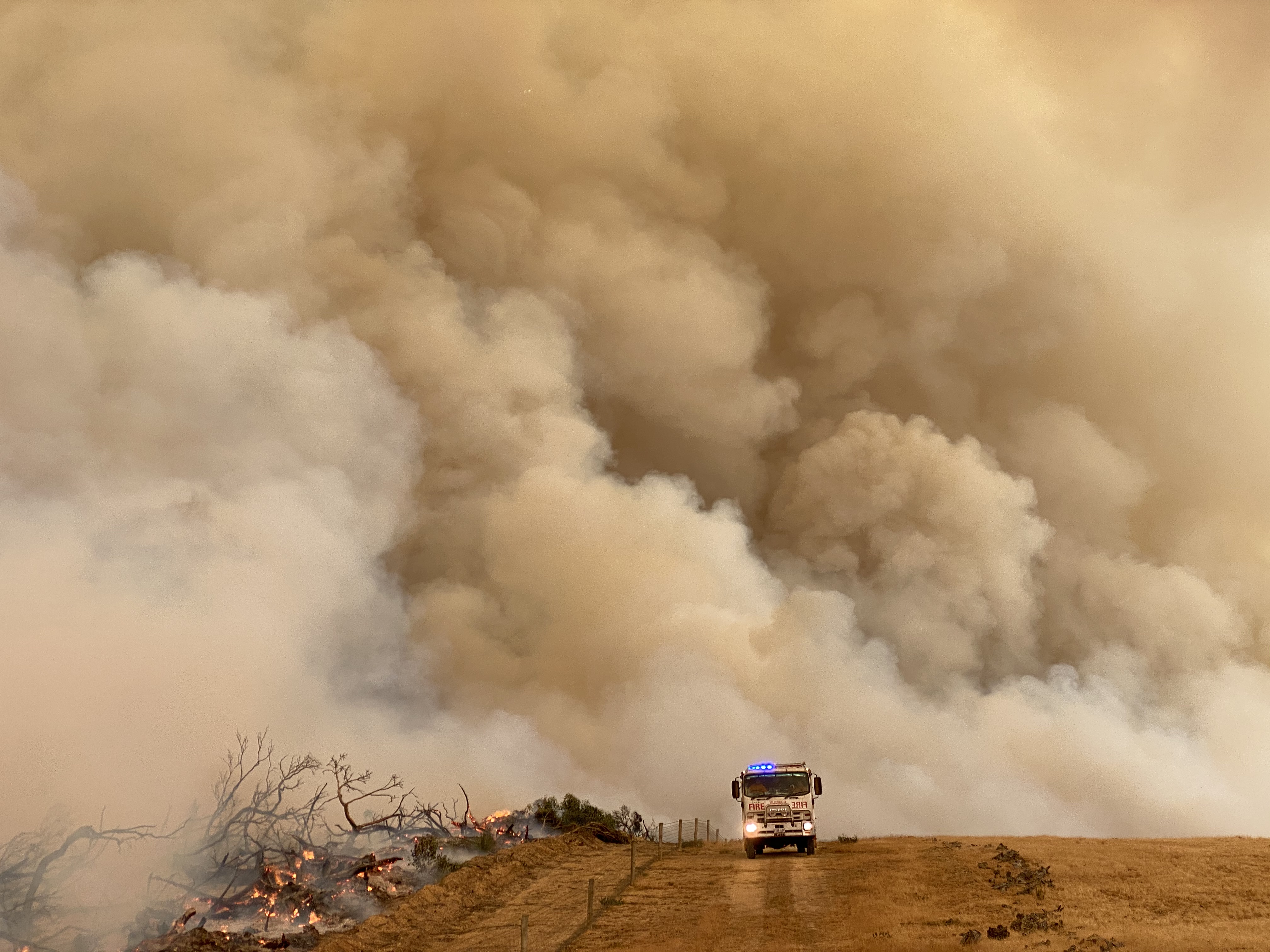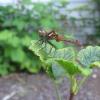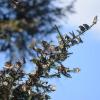In late 2019, wildfires burned across Australia on an unimaginable scale, devastating towns and forests and pushing a rare bee closer to extinction.
This piece originally appeared in the spring 2020 edition of Xerces’ biannual publication Wings. Click to view the full spring 2020 issue.
The impact of the recent Australian wildfires has been devastating and terrifying. The scale is almost in comprehensible: the megafire that burned across the country’s most populous states of New South Wales and Victoria engulfed approximately twenty-three hundred square miles. And that was just one of the 135 bushfires in southeastern Australia that claimed more than two dozen human lives, ruined nearly three thousand homes, and is thought to have killed roughly one billion animals. Although we do not know the full impact that these infernos had on insects and other invertebrates, such wildfires pose a very real danger to the country’s immensely diverse insect populations. One species of native bee might now be teetering on the brink of extinction as a result.
The metallic green carpenter bee (Xylocopa aerata) is the largest native bee in southern Australia, measuring almost an inch long. It’s generally considered a solitary bee—although a mother may share a nest with her daughters—with very specialized nesting needs: trunks of dead banksia (Banksia) and stalks of dead grass trees (Xanthorrhoea), in which the female chews out her nesting tunnel, using the resulting “sawdust” to create partitions that separate the brood cells. The green carpenter bee is one of a relatively small number of bees that can buzz pollinate—other Australian species that can do this include the teddy bear and blue-banded bees (Amegilla)—making it an essential link in the reproduction of native plants, including guinea flower, velvet bush, and fringe, chocolate, and flax lilies, that depend entirely on buzz pollination for reproduction. And because it is a relatively large bee, it visits many different plants in the course of daily foraging.
This male green carpenter bee (Xylocopa aerata) was photographed on Kangaroo Island before the 2019 wildfires consumed its habitat. (Photograph by Remko Leijs.)
Land clearing and previous large bushfires over the past century have already caused local extinction of this species in areas throughout the country. The metallic green carpenter bee was once widely distributed from New South Wales to Kangaroo Island. It is now found only on the eastern flanks of the Great Dividing Range near Sydney in New South Wales, and on the western part of Kangaroo Island.
Australian researchers and volunteers have been working for years to reverse this trend and rehabilitate the species. Banksia, the green carpenter bee’s preferred nesting material, does not survive fire and requires more than thirty years to grow to the right conditions for the bees to use as home. These researchers, led by Dr. Remko Leijs, of the South Australian Museum, and Dr. Katja Hogendoorn, of the University of Adelaide, have been installing artificial nesting stalks for the bee on Kangaroo Island.
At the time that the recent wildfires started in December 2019, the team had established 440 nesting stalks at twelve different locations on the island; 160 of those stalks were occupied with nests containing pupae. Unfortunately, nearly all of those areas burned. In the other place where this bee is known to live, on the east coast of New South Wales, nearly 80 percent of the habitat has been destroyed by fire. So, while the wildfires aren’t solely to blame for the plight of the green carpenter bee, they might ultimately be the event that pushes this bee over the edge to extinction.
Is this what it’s like to lose a species in real time in the Anthropocene Era?
 In late 2019, areas of Kangaroo Island vital for the survival of the metallic green carpenter bee were consumed by massive wildfires. (Photograph by robdownunder / Flickr.)
In late 2019, areas of Kangaroo Island vital for the survival of the metallic green carpenter bee were consumed by massive wildfires. (Photograph by robdownunder / Flickr.)
Estimates of global extinction rates are discussed with much gravity these days. The Millennium Ecosystem Assessment indicates that we are losing twenty-four species a day. A hundred and sixty species a week. Eighty-seven hundred species a year. We have to be a bit careful when using such numbers because they are, after all, estimates—our best educated attempts to put some certainty around an otherwise uncertain situation. But this quantification of extinction is far more than just an academic pursuit. It can and should serve as the standard by which we judge our success or failure at protecting the biodiversity of our world.
Moreover, if we zoom in a bit in terms of both species and geography, there are some things we can say with great confidence. In North America, for example, where more than a quarter of bumble bee species are at risk, five of them—rusty patched, yellow-banded, Crotch’s, Suckley cuckoo, and western—are poised to slip quietly into the evolutionary night unless we act. Franklin’s bumble bee may already have disappeared, and it would have done so unnoticed except for the tireless work of the late Dr. Robbin Thorp.
But in these cases we have been fortunate in one particular way: the decline has been relatively gradual on a human time scale. There is time to notice, time to act. The rusty patched bumble bee is protected under the federal Endangered Species Act because of Xerces’ efforts. Xerces also worked with conservation partners to petition for four other bumble bee species—Crotch’s, Franklin’s, western, and Suckley cuckoo—to be added to California’s endangered list, with follow-up legal action to ensure that it happens. Programs like Bee Better Certified have been created to drive real change among farmers and land managers. Countless community science programs engage the public and inspire action at the local level.
But Australia’s metallic green carpenter bee shows us another possibility for how extinction can happen: suddenly, jarringly, and catastrophically. The bee’s gradual population decline and range contraction put it in a precarious position. Now a single cataclysmic event, one from the deepest nightmares of anthropogenic climate change—a wall of uncontrollable fire walking across the landscape—might finish it off completely. And there’s nothing we can do about it.
If this makes you sad, that’s a good thing. It means you have a heart and that you care. But you can also find strength here. The plight of the green carpenter bee has given us a warning. It has shown us why our own actions to protect species—to increase habitat and range, to decrease the number of persistent threats, to value life in all its forms—are so important. Sudden and catastrophic events will become more likely in our near future. We cannot allow bees or butterflies or fireflies or freshwater mussels or any of the vast number of invertebrate species to be boxed into a similar geographic and reproductive corner.
 Artificial nesting stalks had been placed on Kangaroo Island and were occupied by carpenter bees before the fires. New stalks will be erected in burned areas, giving hope that the surviving carpenter bees will find them and be able to reproduce successfully. Photograph by Remko Leijs.
Artificial nesting stalks had been placed on Kangaroo Island and were occupied by carpenter bees before the fires. New stalks will be erected in burned areas, giving hope that the surviving carpenter bees will find them and be able to reproduce successfully. Photograph by Remko Leijs.
Now that the fires have passed, Drs. Leijs and Hogendoorn and their team of researchers are literally sifting through the ashes to determine what has happened to the green carpenter bee. Recently, in five days of searching, they found twelve nests—a good sign, although previously this number of nests would be found in an hour. The carpenter bees are hanging on, but in very small numbers. The team will return in July to do further surveys and to place fresh artificial nesting stalks in both burned and unburned areas. One hopeful fact is that grass trees flower profusely after fire, as long as the fire has not burned too hot. The grass-tree stalks become available as nesting sites after a couple of years and remain usable for up to six years before collapsing. But, while the landscape recovers, it’s the artificial stalks that will guarantee consistent places for the green carpenter bee to nest. These conservation efforts will continue as long as the bee still survives.
The plight of the green carpenter bee and the potential for its extinction are certainly the results of human action. But it is also human action that will change this. It is the work of human hands that can absolutely preserve the wonderful diversity of species in our world and prevent such terrible losses from happening.
Matt Kelly is an independent journalist. He is the creator, host, and editor of The Bee Report podcast, newsletter, and website, a news site dedicated to helping bee experts, community scientists, and the beecurious stay connected to the wide world of bees. Matt is also working on a documentary film about the bees of Grand Staircase–Escalante National Monument.



